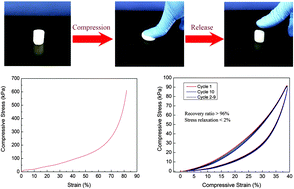Tough polypseudorotaxane supramolecular hydrogels with dual-responsive shape memory properties†
Abstract
Cyclodextrin–polypseudorotaxane hydrogels have attracted extensive attention for their potential application in biomedical fields. Herein, we develop a facile strategy for the in situ formation of mechanically tough polypseudorotaxane hydrogels through photoinitiated copolymerization of poly(ethylene glycol) methyl ether methacrylate, acrylamide and sodium acrylate in α-CD solution at 60 °C. For the first time, we manage to screen the host–guest interaction between α-CD and PEG before copolymerization in the presence of a temporary hydrogen bonding weakening monomer (acrylamide) at a suitable temperature (60 °C). This shielding effect weakens gradually during polymerization, thus leading to the formation of polypseudorotaxane aggregations and a tough physical hydrogel. The hydrogel can bear a large compressive strain (80%) without rupture, and exhibits excellent antifatigue properties. Furthermore, this hydrogel could be endowed with thermal/ascorbic acid activated shape memory performance after being treated with FeCl3 solution. This simple method will contribute to the design and application of smart supramolecular hydrogels.


 Please wait while we load your content...
Please wait while we load your content...